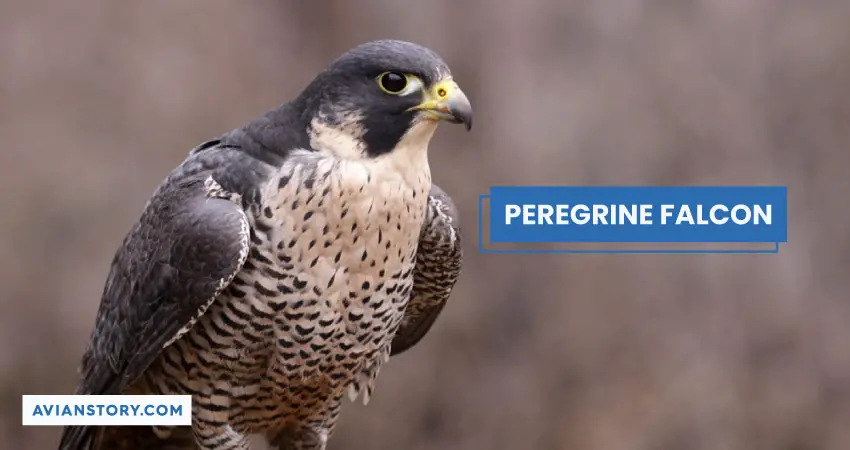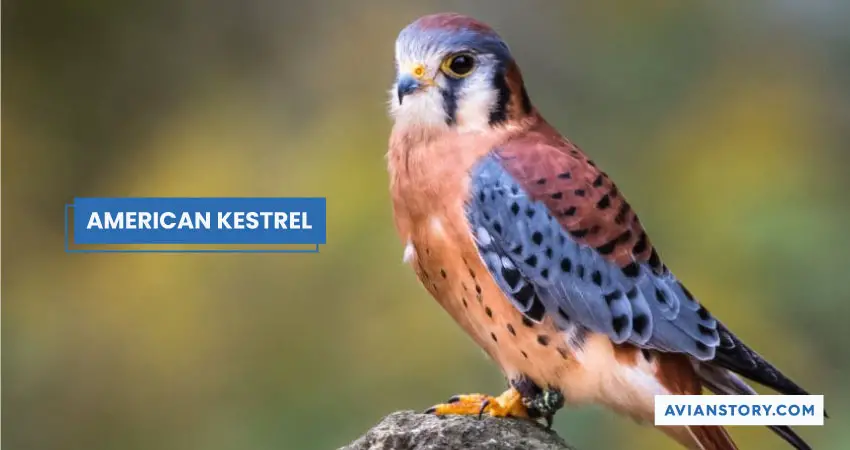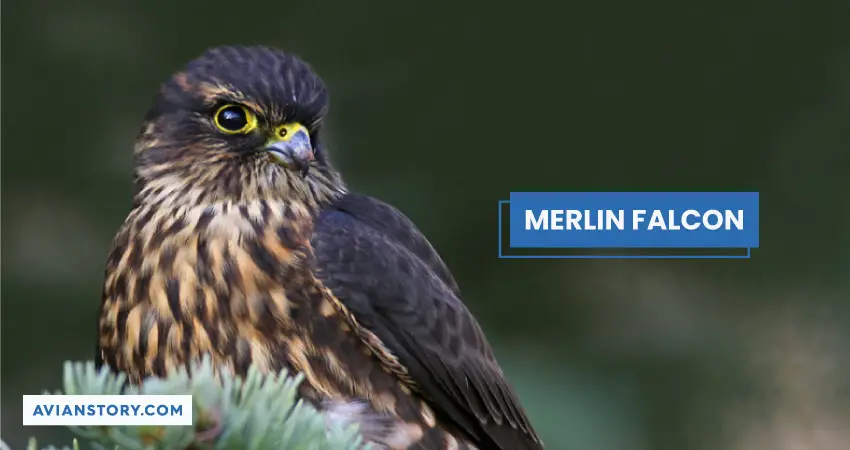4 Species of Falcons in Iowa (Pictures and Facts)
Iowa’s sky, often painted with the stunning hues of a midwestern sunset, is the stage for an air show featuring some of nature’s most adept flyers. Among them, 4 species of falcons command attention with their piercing gazes and powerful wingbeats.
Falcons, members of the Falco genus, are widely known for their speed, agility, and predatory prowess. They possess a unique combination of morphological and behavioral traits, including pointed wings, sharp talons, and exceptional hunting skills. These birds of prey have been subjects of numerous ornithological studies due to their diverse distribution, migratory patterns, and important role in ecosystems.
According to the Iowa Ornithologists’ Union, the state is home to the American Kestrel, Merlin, Peregrine Falcon, and Prairie Falcon. Each species showcases its unique characteristics while sharing common behaviors inherent to falcons, as outlined in research published in the Journal of Avian Biology. This article explores these fascinating falcon species, examining their behaviors, habitats, and the ecological roles they play in Iowa.
The 4 Falcon Species of Iowa
In Iowa, you can find four distinct species of falcons.
- Peregrine Falcon (Falco peregrinus)
- American Kestrel (Falco sparverius)
- Merlin (Falco Columbarius)
- Prairie Falcon (Falco mexicanus)
1. Peregrine Falcon: The Fastest Bird in the World

| Features | Male | Female |
| Size | 14.2-16.1 inches | 16.5-19.3 inches |
| Wingspan | 37.4-41.3 inches | 41.3-45.3 inches |
| Weight | 18.7-26.5 oz | 32.1-48.1 oz |
| Colors | Blue-gray back and wings, white underparts with dark spots | Similar to males, but slightly larger in size |
Recognized as the fastest bird in the world, the Peregrine Falcon, Falco peregrinus, can reach speeds over 240 miles per hour during its hunting stoop (high-speed dive). This bird species is slightly larger than the Merlin, but smaller than the largest of the falcons found in Iowa, the Prairie Falcon.
Peregrine Habitats in Iowa
Once on the verge of extirpation in the United States, Peregrine Falcons have made an exceptional recovery and are now found nesting on tall structures in urban areas across Iowa. Iowa’s capital, Des Moines, and other urban areas have become a refuge for these falcons, offering high-rise buildings that simulate their natural cliffside nesting sites.
Peregrine Diet and Hunting Techniques
The Peregrine Falcon’s diet mainly consists of other birds, such as pigeons and ducks, which they catch mid-flight. Their incredible speed and precision have made them legendary among bird species.
Peregrine Breeding and Nesting Behavior
Peregrine Falcons are monogamous and mate for life. They return to the same nesting spot each year. In Iowa, nesting boxes have been installed on several high-rise buildings to support their breeding efforts.
2. American Kestrel: The Smallest Falcon

| Features | Male | Female |
| Size | 8-12 inches | 9-13 inches |
| Wingspan | 20-24 inches | 21-25 inches |
| Weight | 2.8-4.1 oz | 3.1-4.2 oz |
| Colors | Rufous back, Blue-gray wings | Rufous back, streaked with dark brown |
The American Kestrel, Falco sparverius, is the smallest and most common falcon species found across the United States, and Iowa is no exception. Despite its small size, this bird is a fierce predator, known for its striking coloration, and aerial agility.
Kestrels are characterized by a rusty red back and tail, slate-blue wings, and a distinctive facial pattern. Like all falcons, American Kestrels have a sharp, curved beak and powerful talons to catch and kill their prey.
Kestrel Habitats in Iowa
In Iowa, American Kestrels favor open areas such as fields and farmland, where they can perch on wires or fence posts to spot their prey from afar. They’re year-round residents of the state, and you’re most likely to spot them during daylight hours when they’re most active.
Kestrel Diet and Hunting Techniques
These small raptors primarily feed on insects, small rodents, and birds. American Kestrels are unique among raptors in their hunting strategy. They often hover in the air, wings flapping rapidly, before plunging onto their prey.
Kestrel Breeding and Nesting Behavior
Come spring, American Kestrels become more vocal and active as the breeding season begins. They prefer to nest in cavities, often taking over old woodpecker holes or man-made nest boxes.
The same pattern of behavior, habitats, diet, and breeding can be seen in the other three falcon species, albeit with variations according to their particular species characteristics. So, let’s explore the other three falcon species that call Iowa home.
3. Merlin Falcon: The Stealthy Hunter

| Features | Male | Female |
| Size | 9.4-11.8 inches | 11.4-13 inches |
| Wingspan | 20.9-26.8 inches | 23.6-27.2 inches |
| Weight | 5.6-7.7 oz | 6.7-8.5 oz |
| Colors | Blue-gray to blackish back and wings, pale underparts with thin streaks | Dark brown back and wings, whitish to buffy underparts with brown streaks |
The Merlin Falcon, Falco columbarius, is a small, robust bird of prey, slightly larger than the American Kestrel. Its stealthy nature and high-speed hunting tactics have earned it the nickname “the stealth bomber of the bird world.”
Merlin Habitats in Iowa
Merlin Falcons are migratory birds, and they use Iowa as a stopping point during their journey. They are most commonly seen in the state during fall migration, which happens from late August through November. They can be found in a variety of habitats, including woodlands, grasslands, and suburban areas.
Merlin Diet and Hunting Techniques
Unlike kestrels, Merlin Falcons primarily feed on small birds, which they catch in mid-air using their exceptional speed and agility.
Merlin Breeding and Nesting Behavior
While they do not breed in Iowa, their breeding habits in their nesting areas involve occupying old crow or hawk nests, where they lay 3-5 eggs.
The next falcon species is one that has made a remarkable recovery from the brink of extinction, thanks to concerted conservation efforts – the Peregrine Falcon.
4. Prairie Falcon: The Western Raptor
| Features | Male | Female |
|---|---|---|
| Size | 14.6-16.9 inches | 16.5-18.5 inches |
| Wingspan | 36-43 inches | 40-46 inches |
| Weight | 16.6-27.3 oz | 22.6-38.8 oz |
| Colors | Sandy brown back and wings, white underparts with dark spots | Similar to males, but slightly larger in size |
The largest of Iowa’s falcons, the Prairie Falcon, Falco mexicanus, is native to the western United States, but a few find their way to Iowa each year, primarily during the winter months.
Prairie Habitats in Iowa
As their name suggests, Prairie Falcons are birds of open country. In Iowa, they are often sighted in open fields and grasslands during the winter months.
Prairie Falcon Diet and Hunting Techniques
Prairie Falcons feed on small mammals and birds, which they catch on the ground or in mid-flight. They have a unique “bounce” hunting technique where they drop on their prey from a great height.
Prairie Falcon Breeding and Nesting Behavior
Prairie Falcons do not breed in Iowa, but in their nesting areas out west, they lay their eggs on cliff ledges and in crevices, often reusing the same spot for many years.
The Role of Falcons in Iowa’s Ecosystem
Raptors like falcons serve as nature’s pest control, playing an essential role in maintaining ecological balance. A single falcon can consume hundreds of rodents and insects in a year. By controlling these populations, falcons indirectly aid agricultural activities by reducing crop damage. This biological pest control service, as per a study published in the Journal of Ecological Economics, saves farmers millions of dollars annually in Iowa.
Falcons also add to Iowa’s biodiversity, enriching the state’s wildlife portfolio. According to a report from the Iowa Department of Natural Resources, the presence of these predators is often a good sign of a healthy ecosystem. Falcons, like other top predators, are sensitive to changes in their environment and prey populations, making them useful bio-indicators. Their decline or prosperity can offer critical insights into environmental health and ecosystem dynamics.
Threats to Falcon Populations in Iowa
Despite their crucial ecological roles, Iowa’s falcons face numerous threats. Loss of habitat due to urban development and agriculture is a significant concern. As per a report published in Landscape and Urban Planning, rapid urbanization has led to the disappearance of many natural habitats, causing a decline in falcon populations.
Pollution is another looming threat. Studies in Environmental Science and Technology reveal that pesticide accumulation, especially DDT, can lead to eggshell thinning and reduced falcon fertility. As apex predators, falcons are particularly susceptible to bioaccumulation of toxins.
Climate change also poses challenges by disrupting falcon’s migratory patterns and altering their habitats. Additionally, changes in temperature and precipitation can affect the availability and distribution of prey.
Moreover, falcons face risks from predation and competition from other species. Invasive species like European Starlings often compete with falcons for nesting sites, further straining their populations.
Falcon Conservation in Iowa
Despite the adversities they face, efforts to protect and preserve these raptors are underway across the state.
Legal protections, including the Migratory Bird Treaty Act and the Endangered Species Act, offer a safety net for falcons. They prohibit the possession, sale, and harm of these birds and their habitats, providing a legal framework for their conservation.
Rehabilitation centers across Iowa, like SOAR (Saving Our Avian Resources), play a critical role in rescuing and rehabilitating injured or orphaned raptors. They nurse these birds back to health and reintroduce them into the wild.
In addition, community-based conservation initiatives promote awareness about these birds and their ecological importance. The Des Moines Audubon Society, for instance, organizes bird-watching trips and educational programs that foster appreciation and respect for these raptors.
Urban nesting programs, particularly for the Peregrine Falcon, have seen considerable success. Nest boxes installed on high-rise buildings provide safe nesting sites for these birds, bolstering their urban populations.
Conclusion
Falcons in Iowa are more than just majestic predators gracing the skies. They are crucial players in the state’s ecosystems, contributing significantly to biological diversity and balance. Understanding the distinct characteristics and behaviors of Iowa’s four falcon species opens up a window to appreciate these remarkable birds and underscores the importance of conservation efforts.
The threats that falcons face, such as habitat loss, pollution, and climate change, are largely anthropogenic. As such, we bear the responsibility to mitigate these threats and help ensure their survival. This not only benefits falcons but also strengthens the overall health and diversity of Iowa’s ecosystems. Let us pledge to remain informed and proactive in our conservation efforts to safeguard these vital members of our natural heritage.
Falcons Found in Nearby States of Iowa:
